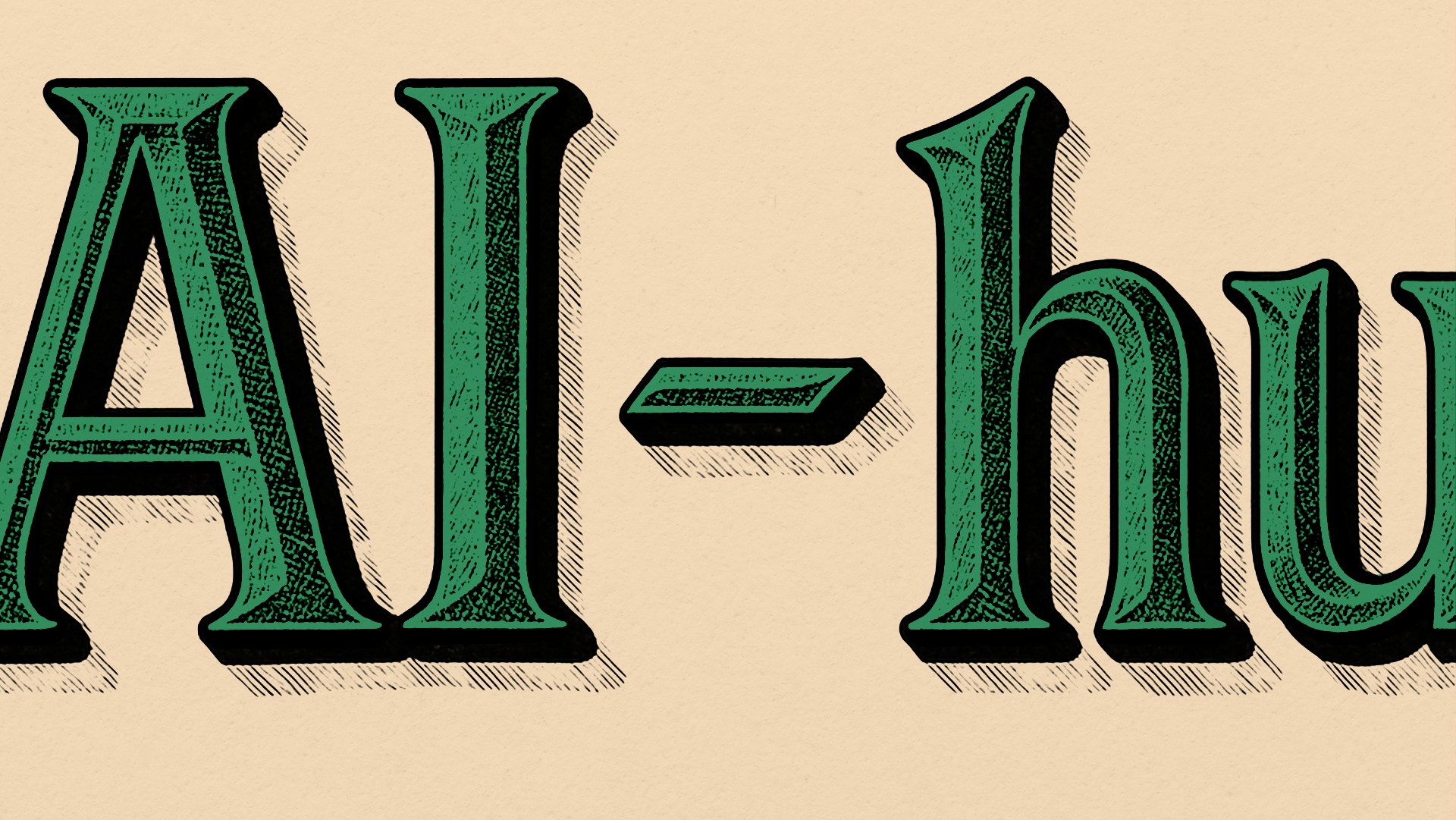
Was this newsletter forwarded to you? Sign up to get it in your inbox.
A few Fridays ago, there was an awkward silence at Every’s editorial meeting.
Six floating heads of writers and editors on Zoom blinked at each other, petrified by a punctuation mark—the em dash.
ChatGPT loooves the em dash—arguably, a bit too much—to the point that it’s become a tell-tale sign of AI-generated writing. (See what I did there?) On the call, we worried—should we avoid using it because it makes our writing sound like AI?
This could be dismissed as a bunch of writers being unduly precious, and maybe we were. But the reason we—and many human writers—are anxious about using em dashes has little to do with punctuation—it’s about trust. (OK, OK, I’ll stop.)
As you scroll down this page, I’m asking for yours: I’m gently taking your hand and inviting you into my thoughts. All the while, a crucial subtext is there saying, in effect: I thought about this, and I cared. You can trust that I did, even if you don’t agree with what I said.
And now a punctuation mark threatens that trust. What I fear most isn’t that my writing will be mistaken for AI, it’s that someone—my editors, fellow writers, or maybe even you—will assume that it didn’t come from a place of care.
AI is rapidly being adopted for its ability to help people accomplish a range of tasks, including writing, more quickly. An increasing number of business leaders now require it. Many writers, though, are facing backlash if their work contains signs of AI use. In some cases, they’re being fired for it. Readers are passing judgment on writing based on appearances, without actually engaging with it. And that’s a problem. (Factual inaccuracies in articles because the writer used AI are, of course, unacceptable.)
We’re living through a moment when the question of how something was made threatens to eclipse what it’s trying to say. Why are we so quick to judge writing based on superficial signs of AI? There has to be a better way to evaluate work that uses it. Instead of asking how something was made, perhaps we should ask whether it’s good—and how we might learn to tell.
Let’s dive in.
Automate your CRM with AI
Remember that important contact you met six months ago? Attio does. Sync your email and calendar to instantly transform all your data into a flexible, AI-powered CRM. With Attio, AI isn’t just a feature—it’s the foundation.
- Instantly find and route leads with research agents
- Get real-time insights during customer conversations
- Build powerful AI automations for your most complex workflows
Get two weeks free. Sign up now.
What the em dash debate tells us about ourselves
Language models didn’t invent em dashes. They learned how to use them from us: There’s been some suggestion that AI overuses em dashes because they’re so common in the training data. The tools we’re now suspicious of are, in many ways, a reflection of our own habits and preferences.
The word “dash” itself traces back to the Middle English word "dashen," meaning “to strike violently,” “to break up (a marriage),” or “to proceed swiftly.” A little dramatic, but kind of perfect given the em dash’s job—to interrupt. It fragments a sentence to emphasize an urgent, interesting thought. In the 19th century, Emily Dickinson was filling her poems with them. I’ve always felt like her liberal use of dashes gives the work a breathless quality, as if she could barely get the words out fast enough.
Dickinson was criticized for the habit, though, and even pre-AI, the short little lines stirred up strong feelings. It’s become a bit of a trope that dashes are overused by writers, and it’s side-eyed by editors, like former editor Slate Noreen Malone, who ironically asked, “Don’t you find it annoying—and you can tell me if you do, I won’t be hurt—when a writer inserts a thought into the midst of another one that’s not yet complete?” (I see you, Noreen.)
Here is where I must declare my love for em dashes. In the bloggy, conversational corner of the internet I write for, it adds something human: quick, seamless transitions, and a rhythm that adds emphasis. But as I alluded to earlier, what makes me upset about AI cannibalizing the em dash goes beyond personal style.
The em dash debate, to me, points to an underlying assumption that if AI helped make something, it couldn’t possibly have been made thoughtfully. That fear doesn’t come out of nowhere. It’s a reaction to the discomfort of living through a technological transition, when the ground is shifting under our feet. We worry that if something is easy to produce, it must be worth less. We worry that the skills we take pride in are being absorbed by something faster, cheaper, and less human.
We can acknowledge these fears, and the unfortunate reality that AI is indeed being used to generate low-quality writing. But the assumption that all writing that involves AI is somehow cheap and worthless is misplaced.
AI has been irreversibly threaded into the fabric of modern knowledge work. Drawing hard lines between what’s human and what’s not is counterproductive. It only serves to distract us from what actually matters: the quality of thought, and by extension, the work itself. This assumption also makes people feel like they have to hide the fact that they’re using these tools at all. And in doing that we risk losing honesty, and the space to experiment in the open.
How to read writing that’s been written with AI
AI writing is in an awkward adolescence, complete with acne, moody silences, and slammed doors. The rules of this new paradigm are still taking shape. Some responses lean into signaling humanness, like the "am dash," a bespoke, downloadable punctuation mark that AI supposedly can’t replicate. Designed by an Australian creative agency, the am dash was created with the intent of being a symbol of “real pondering, genuine daydreaming, and true editorial wordsmithery.” Others aim for transparency at scale; OpenAI, for instance, is looking into ways to identify text generated by ChatGPT.
There are big, unresolved questions around AI that need to be addressed: the spread of misinformation, the murky boundaries of intellectual property, the ethics of attribution. But while we work those out, bad content on the internet—shallow, misleading, and just plain wrong—isn’t a new phenomenon. AI intensifies the issue, but did not create it.
I’ve found my way out of this by being a more active participant in what I read because it forces me to reckon with the bones of the work, rather than lingering on superficial markers. When I’ve genuinely engaged with the substance of a piece, and found real value in its ideas, the question of whether the author used em dashes—or AI—to craft their words becomes irrelevant. The trust between reader and writer is intact. So how do you read that way? Here are a couple of ways that have helped me be a “more active participant” of what I consume on the internet:
Practice curating with intention
Before I begin reading a piece, I stop to ask myself why I’m reading it. This has helped me be more intentional in what I consume. I want to read more thoughtful takes about technology, culture, and how they shape each other, for instance, so I subscribe to independent bloggers Jasmine Sun, Sam Kriss, and Henrik Karlsson I want to learn more about English literature, both classic and contemporary—and I say this as someone who regrets not majoring in it—so I’ve been following writer and critic Henry Oliver, the literary analysis blog A Useful Fiction, and The Paris Review for guidance.
The idea here is to develop a sustainable habit, so think about what you want, and what will feed your curiosity.
Turn information into understanding
I always try to intellectually engage with a piece, instead of passively absorbing information, by highlighting, making summaries, and drawing comparisons. It’s admittedly a little high-friction to commit to doing this, but the payoff is worth it. I’ve experienced this firsthand when writing pieces about Dan Shipper’s podcast, AI & I. As I read the transcript, I made notes about what I found interesting in the conversation. Pausing to reflect on this and structuring it into a coherent article has given me a deeper understanding of the ideas discussed.
The upshot is that the more time and thought you spend with a piece, the less you focus on superficial appearances. This is a big part of how we go about our work at Every. So yes, we still use the em dash—not as a defiant stand, but simply because we find it useful in creating clear, thoughtful writing.
Rhea Purohit is a contributing writer for Every focused on research-driven storytelling in tech. You can follow her on X at @RheaPurohit1 and on LinkedIn, and Every on X at @every and on LinkedIn.
We build AI tools for readers like you. Automate repeat writing with Spiral. Organize files automatically with Sparkle. Deliver yourself from email with Cora.
We also do AI training, adoption, and innovation for companies. Work with us to bring AI into your organization.
Get paid for sharing Every with your friends. Join our referral program.
The Only Subscription
You Need to
Stay at the
Edge of AI
The essential toolkit for those shaping the future
"This might be the best value you
can get from an AI subscription."
- Jay S.
Join 100,000+ leaders, builders, and innovators

Email address
Already have an account? Sign in
What is included in a subscription?
Daily insights from AI pioneers + early access to powerful AI tools








.11.33_PM.png)

Comments
Don't have an account? Sign up!
I've loved em dashes for decades, so it's a shame they've become markers of AI writing. Perhaps AI picked up on them because they're such effective punctuation—much like the semicolon that Cecelia Watson defends in a NYT essay (https://www.nytimes.com/2021/02/09/magazine/the-case-for-semicolons.html). The em dash is so versatile that it's even infiltrated Spanish (the other language I habitually write in), where formal rules technically forbid the single dash.
Your point about moving beyond AI detection hits the mark. Good writing teachers could transform this moment of anxiety into opportunity. Imagine asking students to rewrite their handwritten work to sound like it came from a non-frontier AI model. What changes did they make? Why does AI write that way? Or flip it: take a piece written by a basic AI model and elevate it. What improvements did you make, and why?
Em dashes have long been the tool of masterful writers. Consider this 75-word microfiction piece and how skillfully it deploys em dashes to create rhythm and meaning in such a compressed space: https://www.smokelong.com/stories/thirteen/. That's the kind of intentional punctuation use we should be teaching—and celebrating.